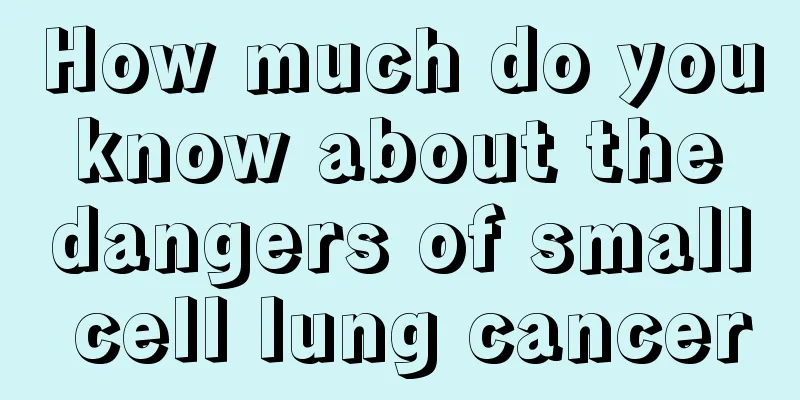How much do you know about the dangers of small cell lung cancer

|
When small cell lung cancer first occurs, we do not find obvious physical symptoms. Therefore, most patients with small cell lung cancer are generally in the middle or late stages. This increases the threat of small cell lung cancer to patients and also creates a great psychological burden for patients. Even if the harm of small cell lung cancer is very great, we must face it. So how much do you know about the harm of small cell lung cancer? If you want to understand the dangers of small cell lung cancer, you must first understand the symptoms of middle and late stage small cell lung cancer. 1. Pain The appearance of pain often indicates that the cancer has entered the middle or late stages. At first, it is usually dull pain or dull pain, which is more obvious at night. Later, it gradually worsens and becomes unbearable, and it continues day and night. Severe pain is a symptom of the late stage of small cell lung cancer. If it occurs, it is usually controlled by drugs. Pain is generally caused by cancer cells invading the nerves. Many people feel extremely painful in the late stages. 2. Bleeding It is caused by cancer tissue invading blood vessels or rupture of small blood vessels in cancer tissue. For example, lung cancer patients may cough up blood and have blood in sputum. Patients with stomach, colon, and esophageal cancer may have blood in their stool. 3. Lump It is mainly manifested by the malignant proliferation of cancer cells, which can be felt by hand on the surface or deep inside the body. Cancer of the thyroid, parotid or breast can be felt in the shallow part of the subcutaneous area. Tumor metastasis to lymph nodes can cause lymph node enlargement. Some superficial lymph nodes, such as cervical lymph nodes and axillary lymph nodes, are easy to feel. Such symptoms become increasingly harmful to small cell patients as the disease worsens. 1. It can cause tracheal obstruction in the patient, the disappearance of normal alveolar sac cavities, and affect the exchange of oxygen and carbon dioxide. The patient will feel chest tightness and shortness of breath. 2. Cancer can also make the patient unable to exclude bacteria, leading to pneumonia and fever. This type of pneumonia is called obstructive pneumonia. 3. Chest pain is one of the more common hazards of lung cancer. Pleural effusion may also occur. Excessive pleural effusion compresses the lungs, making it more difficult for the patient to breathe, and is quite difficult to treat. 4. If the lung tumor occupies a large part of lung cancer, it will seriously threaten the patient's breathing. 5. The occurrence of lung cancer seriously threatens the patient's life. 6. The nerves in the bronchi are quite sensitive. Cancer can irritate the bronchi, causing the patient to cough. If the condition persists for a long time, the patient may also develop symptoms of coughing up blood. The above is my introduction to the dangers of small cell lung cancer. I hope it will be helpful to you. |
<<: What are the common symptoms of small cell lung cancer
>>: A comprehensive analysis of the hazards of small cell lung cancer
Recommend
What are the methods of scalp massage for hair growth
In daily life, we find that many friends suffer f...
What causes acne behind the ears
We all know that acne can appear on the face, but...
Selective disorder
In life, we often face choices, and we become hes...
Does painting walls contain formaldehyde?
Paint will be used to paint the walls during reno...
Is the smell under the armpit body odor?
The arrival of summer allows more people to show ...
What medicine can I take to relieve vomiting after chemotherapy
Chemotherapy can play a very good therapeutic rol...
What are the effects and functions of fried Cyperus rotundus?
The efficacy of fried Cyperus rotundus can be man...
What are the measures to treat lung cancer? The three major clinical treatments for lung cancer
When people have a disease, the first thing they ...
What should I do if my wife has an affair?
If a man finds out that his wife is having an aff...
What is the clinical significance of positive urine nitrite
For healthy people, the laboratory qualitative te...
Postmenopausal women with uterine cancer will bleed again
Postmenopausal women with uterine cancer will ble...
What are the key points in diagnosing fibroids
Fibroids are difficult to detect in the early sta...
What are the more obvious symptoms of lung cancer? These symptoms of lung cancer are more common
Because the early symptoms of lung cancer are not...
What are some examination methods you need to know after you have rectal cancer
Nowadays, many people may suffer from rectal canc...
Comparison between liver palm and normal palm
The main difference between liver palms and norma...









